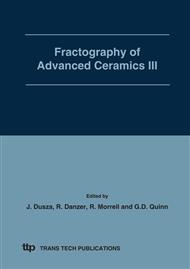[1]
W. Dahl. R. Kopp and O. Pawelski: Umformtechnik, Plastomechanik und Werkstoffkunde (Verlag Stahleisen, Düsseldorf, Deutschland 1993).
Google Scholar
[2]
W. Zleppnig, private communications, (2008).
Google Scholar
[3]
W. Zleppnig, R. Danzer, F.D. Fischer and K.L. Maurer: Influence of the Structure and the Temperature Field on the Formation and Propagation of Thermal Fatigue Cracks, in: Proc. ECF 6, Vol II, edited by H.C. van Elst and A. Bakker, EMAS, Warley, UK, (1986).
Google Scholar
[4]
W. Zleppnig: Keramische Drahtwalzen, Führungsrollen und Drahtführungshülsen, in: Walzen mit Keramik, edited by A. Kailer and T. Hollstein Fraunhofer IRB Verlag, Stuttgart, Deutschland, (2004) p.85.
Google Scholar
[5]
A. Kailer, J. Kozlowski, K. Berroth, G. Wötting, W. Zleppnig, R. Danzer and M. Lengauer: Keramische Walzwerkzeuge für die Herstellung von Drähten, Rohren und Bändern, Industrie Diamanten Rundschau Vol. 37 (2003), p.2.
Google Scholar
[6]
A. Kailer and Th. Hollstein (eds. ): Walzen mit Keramik (Fraunhofer IRB Verlag, Stuttgart, 2004).
Google Scholar
[7]
M. Lengauer, R. Danzer and W. Harrer: Keramische Walzen für das Drahtwalzen-Simulation und Analyse der Werkzeugbeanspruchung, in: Walzen mit Keramik edited by A. Kailer and T. Hollstein Fraunhofer IRB Verlag, Stuttgart, Deutschland, (2004) p.95.
Google Scholar
[8]
M. Lengauer, R. Danzer, D. Rubeša, W. Harrer and W. Zleppnig: Key Eng. Mater. Vol. 290 (2005), p.94.
Google Scholar
[9]
M. Lengauer: Einsatz von Si3N4-Keramik als Werkstoff für Walzwerkzeuge zum Warmwalzen von Draht. Thesis, Montanuniversität Leoben, Leoben, Austria (2007).
Google Scholar
[10]
R. Danzer, M. Lengauer, W. Zleppnig and W. Harrer: Int. J. Mater. Res. Vol. 98 (2007), p.1104.
Google Scholar
[11]
M. Lengauer and R. Danzer: J. Eur. Ceram. Soc. Vol. 28 (2008), p.2289.
Google Scholar
[12]
M. Lengauer and R. Danzer: Silicon Nitride Materials for Hot Working High Strength Metal Wires, Proc. ECF 17, (2008) in press.
DOI: 10.1016/j.engfailanal.2009.05.003
Google Scholar
[13]
M. Raudensky, J. Horsky and M. Pohanka: J. Mater. Process. Technol. Vol. 125-126 (2002), p.700.
Google Scholar
[14]
D. Zhao, P. K. Chaudhury, R.B. Frank and L.A. Jackman: Flow Behavior of Three 625-Type Alloys during High Temperature Deformation, in: Superalloys 718, 625, 706 and Various Derivatives, edited by E. A. Loria, The Minerals, Metals & Materials Society, Warrendale, Pennsylvania, USA (1994).
DOI: 10.7449/1994/superalloys_1994_315_329
Google Scholar
[15]
Z. Wusatowski: Grundlagen des Walzens (VEB Deutscher Verlag für Grundstoffindustrie, Leipzig, Deutschland 1963).
Google Scholar
[16]
H. Hertz: Über die Berührung fester elastischer Körper, J. reine Angewandte Mathematik Vol. 92 (1881), p.156.
DOI: 10.1515/9783112342404-004
Google Scholar
[17]
B.R. Lawn: J. Am. Ceram. Soc. Vol. 81 (1998), p. (1977).
Google Scholar
[18]
R. Danzer: Key Eng. Mat. Vol. 223 (2002), p.1.
Google Scholar
[19]
R. Danzer, T. Lube, P. Supancic and R. Damani: Adv. Eng. Mater. Vol. 10 (2008), p.275.
DOI: 10.1002/adem.200700347
Google Scholar
[20]
H.J. Petroski and J.D. Achenbach: Eng. Fract. Mech. Vol. 10 (1978), p.257.
Google Scholar
[21]
T. Fett: Stress intensity factors - T-Stresses - Weight Functions, Schriftenreihe des Institutes für Keramik im Maschinenbau IKM 50, Universitätsverlag Karlsruhe (2008).
Google Scholar
[22]
R. Morrell, W. Harrer, R. Danzer and K. Berroth: Failure investigation of forming rolls made of Si3N4, this proceedings.
Google Scholar
[23]
D. Munz and T. Fett: Ceramics: Mechanical Properties, Failure Behaviour, Materials Selection (Springer Verlag, Berlin, Heidelberg, Deutschland 1999).
DOI: 10.1007/978-3-642-58407-7
Google Scholar
[24]
R. Danzer: Sub-Critical Crack Growth in Ceramics, in: Encyclopaedia of Advanced Materials, Vol. 4, edited by R.W. Cahn and R.J. Brook Pergamon Press, Oxford, UK, (1994), p.2693.
Google Scholar
[25]
T. Lube, R. Danzer, J. Kübler, J. Dusza, J. -P. Erauw, H. Klemm and V.M. Sglavo: Strength and Fracture Toughness of the ESIS Silicon Nitride Reference Material, in: Fracture Beyond 2000 - Proc. of ECF 14, Vol. 2, Cracow, Poland (2002) p.409.
Google Scholar
[26]
T. Kawakubo and K. Komeya: J. Am. Ceram. Soc. Vol. 70 (1987), p.400.
Google Scholar
[27]
C.J. Gilbert, R.H. Dauskardt and R.O. Ritchie: J. Am. Ceram. Soc. Vol. 78 (1995), p.2291.
Google Scholar
[28]
H. Kishimoto, A. Ueno, H. Kawamoto and Y. Fujii: J. Soc. Mater. Sci. Jpn. Vol. 38 (1989), p.1212.
Google Scholar
[29]
Y. Mutho, M. Takahashi and A. Kanagawa: Fatigue Crack Growth Behavior of Surface Cracks in Silicon Nitride, in: Cyclic Deformation, Fracture, and "ondestructive Evaluation of Advanced Materials. Second Volume, ASTM STP 1184, edited by M.R. Mitchell and Otto Buck, American Society for Testing and Materials, Philadelphia (1994).
DOI: 10.1520/stp18117s
Google Scholar
[30]
M. Okazaki, A.J. McEvily and T. Tanaka: Metall. Trans. Vol. 22 (1991), p.1425.
Google Scholar
[31]
T. Tanaka, N. Okabe and Y. Ishimaru: Transactions of JSMS, Vol. 38, No. 425 (1987), p.137.
Google Scholar
[32]
C.J. Gilbert, R.H. Dauskardt and R.O. Ritchie: Ceram. Int. Vol. 23 (1997), p.413.
Google Scholar
[33]
K. Urashima et al.: Cyclic Fatigue Behaviour of In-situ Toughened Silicon Nitrides, in: Cyclic Fatigue in Ceramics (Current Japanese Materials Research Vol. 14), edited by H. Kishimoto, T. Hoshide and N. Okabe, Elsevier Science BV and The Society of Material Science, Japan (1995).
Google Scholar


